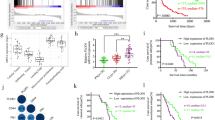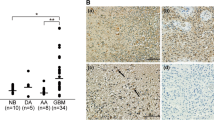Abstract
Procollagen-lysine, 2-oxoglutarate 5-dioxygenase 1 (PLOD1) is a collagen-related lysyl hydroxylase and its prognostic value in glioma patients was verified. However, its biological function in glioma has yet to be fully investigated. The PLOD1 mRNA status and clinical significance in gliomas were assessed via the GEPIA database. Overexpression or targeted depletion of PLOD1 was carried out in the human glioma cell line U87 and verified by western blotting. CCK8 and colony formation assays were implemented to examine the impact of PLOD1 on the proliferative and colony-forming phenotypes of U87 cells. Luciferase reporter assays and HSF1-specific pharmacologic inhibitors (KRIBB11) were employed to determine the regulatory relationship between PLOD1 and heat shock factor 1 (HSF1). High expression of PLOD1 was observed in tissue samples of glioblastoma multiforme (GBM) and brain lower-grade glioma (LGG). GEPIA overall survival further demonstrated that both GBM and LGG patients with high PLOD1 displayed worse clinical outcomes compared with those with low PLOD1. Overexpression and targeted depletion of PLOD1 enhanced and suppressed U87 cell proliferation and colony formation, respectively. Luciferase reporter assays showed that PLOD1 significantly enhanced the transcriptional activity of HSF1 in HEK293T cells. PLOD1 deficiency in U87 cells inhibited HSF1-induced survivin accumulation, whereas KRIBB11 also blocked the PLOD1-overexpressing induced survivin expression. An inhibitor of HSF1 signaling events abolished the increased clonogenic potential caused by PLOD1 overexpression in U87 cells. High expression of PLOD1 can increase the proliferation and colony formation of U87 cells by activating the HSF1 signaling pathway. This study suggested PLOD1/HSF1 as an effective therapeutic target for gliomas.
Access this article
We’re sorry, something doesn't seem to be working properly.
Please try refreshing the page. If that doesn't work, please contact support so we can address the problem.




Similar content being viewed by others
References
Zeng T, Cui D, Gao L (2015) Glioma: an overview of current classifications, characteristics, molecular biology and target therapies. Front Biosci (Landmark Ed) 20:1104–1115. https://doi.org/10.2741/4362
Davis ME (2016) Glioblastoma: overview of disease and treatment. Clin J Oncol Nurs 20(5 Suppl):S2-8. https://doi.org/10.1188/16.CJON.S1.2-8
Ostrom QT, Cioffi G, Gittleman H, Patil N, Waite K, Kruchko C et al (2019) CBTRUS statistical report: primary brain and other central nervous system tumors diagnosed in the United States in 2012–2016. Neuro Oncol 21(Suppl 5):v1–v100. https://doi.org/10.1093/neuonc/noz150
Ostrom QT, Gittleman H, Stetson L, Virk SM, Barnholtz-Sloan JS (2015) Epidemiology of gliomas. Cancer Treat Res 163:1–14. https://doi.org/10.1007/978-3-319-12048-5_1
Hautala T, Byers MG, Eddy RL, Shows TB, Kivirikko KI, Myllyla R (1992) Cloning of human lysyl hydroxylase: complete cDNA-derived amino acid sequence and assignment of the gene (PLOD) to chromosome 1p36.3––p36.2. Genomics 13(1):62–69. https://doi.org/10.1016/0888-7543(92)90202-4
Jover E, Silvente A, Marin F, Martinez-Gonzalez J, Orriols M, Martinez CM et al (2018) Inhibition of enzymes involved in collagen cross-linking reduces vascular smooth muscle cell calcification. FASEB J 32(8):4459–4469. https://doi.org/10.1096/fj.201700653R
Scietti L, Campioni M, Forneris F (2019) SiMPLOD, a structure-integrated database of collagen lysyl hydroxylase (LH/PLOD) enzyme variants. J Bone Miner Res 34(7):1376–1382. https://doi.org/10.1002/jbmr.3692
Qi Y, Xu R (2018) Roles of PLODs in collagen synthesis and cancer progression. Front Cell Dev Biol 6:66. https://doi.org/10.3389/fcell.2018.00066
Saha SK, Ghosh P, Konar A, Bhattacharya S, Roy SS (2005) Differential expression of procollagen lysine 2-oxoglutarate 5-deoxygenase and matrix metalloproteinase isoforms in hypothyroid rat ovary and disintegration of extracellular matrix. Endocrinology 146(7):2963–2975. https://doi.org/10.1210/en.2004-1440
Heikkinen J, Hautala T, Kivirikko KI, Myllyla R (1994) Structure and expression of the human lysyl hydroxylase gene (PLOD): introns 9 and 16 contain Alu sequences at the sites of recombination in Ehlers-Danlos syndrome type VI patients. Genomics 24(3):464–471. https://doi.org/10.1006/geno.1994.1654
Takaluoma K, Hyry M, Lantto J, Sormunen R, Bank RA, Kivirikko KI et al (2007) Tissue-specific changes in the hydroxylysine content and cross-links of collagens and alterations in fibril morphology in lysyl hydroxylase 1 knock-out mice. J Biol Chem 282(9):6588–6596. https://doi.org/10.1074/jbc.M608830200
Yeowell HN, Steinmann B (1993) PLOD1-Related Kyphoscoliotic Ehlers-Danlos Syndrome. In: Adam MP, Ardinger HH, Pagon RA, Wallace SE, Bean LJH, Stephens K et al (eds) GeneReviews((R)). University of Washington, Seattle. PMID: 20301635
Wang D, Zhang S, Chen F (2018) High expression of PLOD1 drives tumorigenesis and affects clinical outcome in gastrointestinal carcinoma. Genet Test Mol Biomark 22(6):366–373. https://doi.org/10.1089/gtmb.2018.0009
Boonsongserm P, Angsuwatcharakon P, Puttipanyalears C, Aporntewan C, Kongruttanachok N, Aksornkitti V et al (2019) Tumor-induced DNA methylation in the white blood cells of patients with colorectal cancer. Oncol Lett 18(3):3039–3048. https://doi.org/10.3892/ol.2019.10638
Chang WH, Forde D, Lai AG (2019) Dual prognostic role of 2-oxoglutarate-dependent oxygenases in ten cancer types: implications for cell cycle regulation and cell adhesion maintenance. Cancer Commun (Lond) 39(1):23. https://doi.org/10.1186/s40880-019-0369-5
Yamada Y, Kato M, Arai T, Sanada H, Uchida A, Misono S et al (2019) Aberrantly expressed PLOD1 promotes cancer aggressiveness in bladder cancer: a potential prognostic marker and therapeutic target. Mol Oncol 13(9):1898–1912. https://doi.org/10.1002/1878-0261.12532
Gawel DR, Lee EJ, Li X, Lilja S, Matussek A, Schafer S et al (2019) An algorithm-based meta-analysis of genome- and proteome-wide data identifies a combination of potential plasma biomarkers for colorectal cancer. Sci Rep 9(1):15575. https://doi.org/10.1038/s41598-019-51999-9
Wu X, Xiang H, Cong W, Yang H, Zhang G, Wang Y et al (2020) PLOD1, a target of miR-34c, contributes to cell growth and metastasis via repressing LATS1 phosphorylation and inactivating hippo pathway in osteosarcoma. Biochem Biophys Res Commun 527(1):29–36. https://doi.org/10.1016/j.bbrc.2020.04.052
Zeng H, Li H, Zhao Y, Chen L, Ma X (2019) Transcripto-based network analysis reveals a model of gene activation in tongue squamous cell carcinomas. Head Neck 41(12):4098–4110. https://doi.org/10.1002/hed.25952
Dao Trong P, Rosch S, Mairbaurl H, Pusch S, Unterberg A, Herold-Mende C et al (2018) Identification of a prognostic hypoxia-associated gene set in IDH-mutant glioma. Int J Mol Sci. https://doi.org/10.3390/ijms19102903
Garbuz DG (2017) Regulation of heat shock gene expression in response to stress. Mol Biol (Mosk) 51(3):400–417. https://doi.org/10.7868/S0026898417020100
Dai C (2018) The heat-shock, or HSF1-mediated proteotoxic stress, response in cancer: from proteomic stability to oncogenesis. Philos Trans R Soc Lond B Biol Sci. https://doi.org/10.1098/rstb.2016.0525
Rajesh Y, Biswas A, Mandal M (2017) Glioma progression through the prism of heat shock protein mediated extracellular matrix remodeling and epithelial to mesenchymal transition. Exp Cell Res 359(2):299–311. https://doi.org/10.1016/j.yexcr.2017.08.032
Yang I, Fang S, Parsa AT (2010) Heat shock proteins in glioblastomas. Neurosurg Clin N Am 21(1):111–123. https://doi.org/10.1016/j.nec.2009.09.002
Kijima T, Prince T, Neckers L, Koga F, Fujii Y (2019) Heat shock factor 1 (HSF1)-targeted anticancer therapeutics: overview of current preclinical progress. Expert Opin Ther Targets 23(5):369–377. https://doi.org/10.1080/14728222.2019.1602119
Holmes B, Benavides-Serrato A, Freeman RS, Landon KA, Bashir T, Nishimura RN et al (2018) mTORC2/AKT/HSF1/HuR constitute a feed-forward loop regulating Rictor expression and tumor growth in glioblastoma. Oncogene 37(6):732–743. https://doi.org/10.1038/onc.2017.360
Li L, Wang W, Li X, Gao T (2017) Association of ECRG4 with PLK1, CDK4, PLOD1 and PLOD2 in esophageal squamous cell carcinoma. Am J Transl Res 9(8):3741–3748
Xu WH, Xu Y, Wang J, Tian X, Wu J, Wan FN et al (2019) Procollagen-lysine, 2-oxoglutarate 5-dioxygenases 1, 2, and 3 are potential prognostic indicators in patients with clear cell renal cell carcinoma. Aging (Albany NY) 11(16):6503–6521. https://doi.org/10.18632/aging.102206
Manerba M, Di Ianni L, Govoni M, Roberti M, Recanatini M, Di Stefano G (2017) LDH inhibition impacts on heat shock response and induces senescence of hepatocellular carcinoma cells. Eur J Pharm Sci 105:91–98. https://doi.org/10.1016/j.ejps.2017.05.015
Toma-Jonik A, Vydra N, Janus P, Widlak W (2019) Interplay between HSF1 and p53 signaling pathways in cancer initiation and progression: non-oncogene and oncogene addiction. Cell Oncol (Dordr) 42(5):579–589. https://doi.org/10.1007/s13402-019-00452-0
Lou Q, Li Y, Hou B, Liu Y, Zhang Y, Hao J et al (2019) Heat shock transcription factor 1 affects kidney tubular cell migration by regulating the TGFbeta1Smad2/3 signaling pathway. Mol Med Rep 20(5):4323–4330. https://doi.org/10.3892/mmr.2019.10689
Seo MS, Oh SY, Park MJ, Kim SM, Kim MY, Han SI et al (2005) Implication of reactive oxygen species, ERK1/2, and p38MAPK in sodium salicylate-induced heat shock protein 72 expression in C6 glioma cells. Int J Mol Med 16(5):841–849
Author information
Authors and Affiliations
Corresponding author
Ethics declarations
Conflict of interest
All authors declared there were no conflict of interest involved.
Additional information
Publisher's Note
Springer Nature remains neutral with regard to jurisdictional claims in published maps and institutional affiliations.
Rights and permissions
About this article
Cite this article
Yuan, B., Xu, Y. & Zheng, S. PLOD1 acts as a tumor promoter in glioma via activation of the HSF1 signaling pathway. Mol Cell Biochem 477, 549–557 (2022). https://doi.org/10.1007/s11010-021-04289-w
Received:
Accepted:
Published:
Issue Date:
DOI: https://doi.org/10.1007/s11010-021-04289-w




